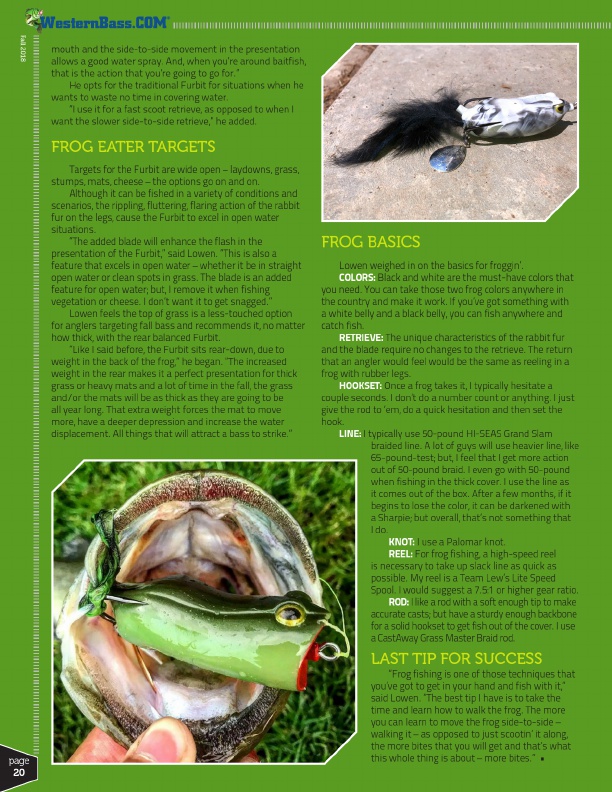
®
Fall 2018
page 20
mouth and the side-to-side movement in the presentation allows a good water spray. And, when you’re around baitfish, that is the action that you’re going to go for.”
He opts for the traditional Furbit for situations when he wants to waste no time in covering water.
“I use it for a fast scoot retrieve, as opposed to when I want the slower side-to-side retrieve,” he added.
FROG EATER TARGETS
Targets for the Furbit are wide open – laydowns, grass, stumps, mats, cheese – the options go on and on.
Although it can be fished in a variety of conditions and scenarios, the rippling, fluttering, flaring action of the rabbit fur on the legs, cause the Furbit to excel in open water situations.
“The added blade will enhance the flash in the presentation of the Furbit,” said Lowen. “This is also a feature that excels in open water – whether it be in straight open water or clean spots in grass. The blade is an added feature for open water; but, I remove it when fishing vegetation or cheese. I don’t want it to get snagged.”
Lowen feels the top of grass is a less-touched option for anglers targeting fall bass and recommends it, no matter how thick, with the rear balanced Furbit.
“Like I said before, the Furbit sits rear-down, due to weight in the back of the frog,” he began. “The increased weight in the rear makes it a perfect presentation for thick grass or heavy mats and a lot of time in the fall, the grass and/or the mats will be as thick as they are going to be all year long. That extra weight forces the mat to move more, have a deeper depression and increase the water displacement. All things that will attract a bass to strike.”
FROG BASICS
Lowen weighed in on the basics for froggin’.
COLORS: Black and white are the must-have colors that you need. You can take those two frog colors anywhere in the country and make it work. If you’ve got something with a white belly and a black belly, you can fish anywhere and catch fish.
RETRIEVE: The unique characteristics of the rabbit fur and the blade require no changes to the retrieve. The return that an angler would feel would be the same as reeling in a frog with rubber legs.
HOOKSET: Once a frog takes it, I typically hesitate a couple seconds. I don’t do a number count or anything. I just give the rod to ‘em, do a quick hesitation and then set the hook.
LINE: I typically use 50-pound HI-SEAS Grand Slam
braided line. A lot of guys will use heavier line, like
65-pound-test; but, I feel that I get more action
out of 50-pound braid. I even go with 50-pound
when fishing in the thick cover. I use the line as
it comes out of the box. After a few months, if it
begins to lose the color, it can be darkened with
a Sharpie; but overall, that’s not something that
I do.
KNOT: I use a Palomar knot.
REEL: For frog fishing, a high-speed reel
is necessary to take up slack line as quick as
possible. My reel is a Team Lew’s Lite Speed
Spool. I would suggest a 7.5:1 or higher gear ratio.
ROD: I like a rod with a soft enough tip to make
accurate casts; but have a sturdy enough backbone
for a solid hookset to get fish out of the cover. I use
a CastAway Grass Master Braid rod.
LAST TIP FOR SUCCESS
“Frog fishing is one of those techniques that you’ve got to get in your hand and fish with it,” said Lowen. “The best tip I have is to take the time and learn how to walk the frog. The more you can learn to move the frog side-to-side – walking it – as opposed to just scootin’ it along, the more bites that you will get and that’s what this whole thing is about – more bites.” •